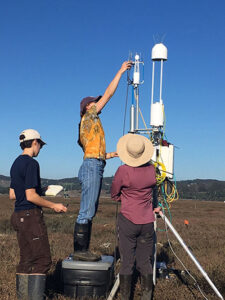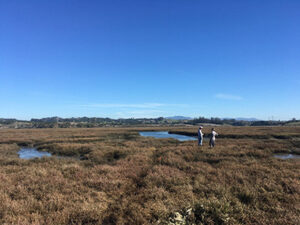Healthy coastal wetlands can help combat climate change by absorbing large amounts of carbon dioxide from the atmosphere and storing it for the long term. Restored coastal wetlands also provide habitat for fish and other wildlife, reduce erosion and coastal flooding, improve water quality, and support recreational uses.
Recognition of these ecosystem services, coupled with widespread loss and degradation of coastal wetlands, has spurred restoration efforts throughout California and around the world.
Little is known, however, about how specific restoration and management practices influence the capture and storage of carbon (“carbon sequestration”) and other benefits of coastal wetlands.
Now, a large interdisciplinary team of scientists is working to develop policy and management guidelines to maximize carbon sequestration in coastal wetlands along with other benefits for humans and nature.
Led by Adina Paytan, a research scientist at the UC Santa Cruz Institute of Marine Sciences, the collaborative project involves researchers at five UC campuses and three national laboratories and is funded by a $3.6 million grant from the UC National Laboratory Fees Research Program.

Adina Paytan leads an interdisciplinary collaboration to study coastal wetland restoration for climate mitigation and other benefits.. Photo courtesy of UCSC.
“Considering California’s goal of achieving carbon neutrality, there is no way we can do that without sequestering carbon dioxide from the atmosphere, and nature-based solutions like wetland restoration are among the most economical and effective strategies,” Paytan said. “This project will evaluate how coastal wetland restoration can be designed and executed in a way that will provide the most benefits for people and ecosystems.”
Components of the project include research on carbon dynamics in coastal wetlands; economic assessment of carbon storage and other ecosystem services from coastal wetlands; development of a policy and governance framework for wetland restoration; and incorporating carbon dynamics, restoration options, and climate trends in ecosystem models to improve projections of carbon sequestration benefits from coastal wetlands.
The project brings together UC experts in these areas at the Santa Cruz, Berkeley, Davis, Santa Barbara, and Irvine campuses, as well as scientists at Lawrence Berkeley National Laboratory, Lawrence Livermore National Laboratory, and Los Alamos National Laboratory. Field research will take place at wetland sites in San Francisco Bay, the Delta, and Elkhorn Slough, taking advantage of existing research infrastructure where Paytan and other investigators have ongoing research programs.
Plants absorb carbon dioxide as they grow, incorporating carbon into organic matter. Burial of that carbon in soils and sediments can sequester it, but decomposition processes can release it back into the atmosphere as greenhouse gases. Understanding and quantifying the processes that govern the net burial rates of carbon in coastal wetlands is crucial for designing the most effective restoration and management practices.
“We have to know how to maximize burial and minimize emissions in a way that is sustainable over the long run, especially with sea level rise,” Paytan said. “You have to look at all the variables together to see the net effect, and none of this has been modeled in a holistic way. That’s where the national labs come in, because they have these wonderful ecosystem modeling tools that will be really useful.”

UCSC researchers set up an “eddy covariance” tower in Elkhorn Slough with instruments for measuring environmental parameters, including the flux of carbon dioxide and methane into and out of the wetlands. Photo courtesy of Adina Paytan.
The contributions of social scientists to the project are also crucial, she said. Quantifying wetland ecosystem services will enable the economic value of carbon storage and other benefits to be included in decisions on wetland restoration and support wider use of nature-based solutions for climate mitigation. The project will also integrate environmental justice considerations, policy, and governance approaches to develop a framework and guidelines for incorporating coastal wetland restoration and conservation into local, state, and national plans for climate adaptation.
“It’s one thing to know as scientists what we need to do, but we also need to understand what the implications are to people and how to navigate a complex regulatory system and actually achieve our goals,” Paytan continued. “I’ve worked with some of the investigators before on wetlands research, but we realized this needed a bigger project involving social scientists as well. When I started reaching out, it was really nice because everyone recognized how important this is and they were excited to contribute.”
The close collaboration of researchers from different disciplines is essential for developing sustainable climate mitigation solutions that enhance community resilience and environmental justice. The funding for this project will support graduate and undergraduate student researchers as well as education and outreach components such as an undergraduate course on climate and data literacy offered at the participating UC campuses.
The UC National Laboratory Fees Research Program enhances partnerships between UC researchers and scientists at national laboratories. Funds for these strategic investments derive from the net fee income UC receives for managing the Los Alamos, Lawrence Berkeley, and Lawrence Livermore National Laboratories on behalf of the U.S. Department of Energy.
Featured photo shows UC Santa Cruz Institute of Marine Sciences lab.


